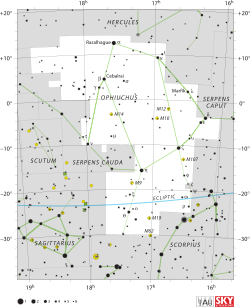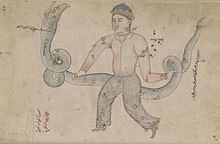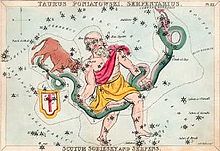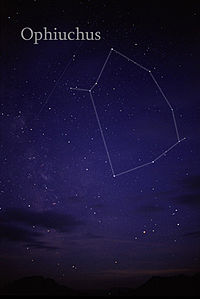- Ophiuchus
-
Ophiuchus Constellation 
List of stars in OphiuchusAbbreviation Oph Genitive Ophiuchi Pronunciation /ˌɒfiːˈjuːkəs/ Óphiúchus, genitive /ˌɒfiːˈjuːkaɪ/ Symbolism the serpent-bearer Right ascension 17 h Declination −8° Quadrant SQ3 Area 948 sq. deg. (11th) Main stars 10 Bayer/Flamsteed
stars62 Stars with planets 7 Stars brighter than 3.00m 5 Stars within 10.00 pc (32.62 ly) 11 Brightest star α Oph (Ras Alhague) (2.08m) Nearest star Barnard's Star
(5.98 ly, 1.83 pc)Messier objects 7 Meteor showers Ophiuchids
Northern May Ophiuchids
Southern May Ophiuchids
Theta OphiuchidsBordering
constellationsHercules
Serpens
Libra
Scorpius
Sagittarius
AquilaVisible at latitudes between +80° and −80°.
Best visible at 21:00 (9 p.m.) during the month of July.Ophiuchus is a large constellation located around the celestial equator. Its name is from the Greek Ὀφιοῦχος "serpent-bearer", and it is commonly represented as a man grasping the snake that is represented by the constellation Serpens. Ophiuchus was one of the 48 constellations listed by the 2nd-century astronomer Ptolemy, and it remains one of the 88 modern constellations. It was formerly referred to as Serpentarius (English pronunciation: /ˌsɜrpənˈtɛəriəs/; also Anguitenens), a Latin word meaning the same as its current name.
Contents
Location
It is located between Aquila, Serpens and Hercules, northwest of the center of the Milky Way. The southern part lies between Scorpius to the west and Sagittarius to the east. It is best visible in the northern summer and located opposite Orion in the sky. Ophiuchus is depicted as a man grasping a serpent; the interposition of his body divides the snake constellation Serpens into two parts, Serpens Caput and Serpens Cauda, which are nonetheless counted as one constellation.
Notable features
Stars
The brightest stars in Ophiuchus include α Ophiuchi, called Rasalhague (at the figure's head), and η Ophiuchi.
RS Ophiuchi is part of a class called recurrent novae, whose brightness increase at irregular intervals by hundreds of times in a period of just a few days. It is thought to be at the brink of becoming a type-1a supernova.[2]
Barnard's Star, one of the nearest stars to the Solar System (the only stars closer are the Alpha Centauri binary star system and Proxima Centauri), lies in Ophiuchus. (It is located to the left of β and just north of the V-shaped group of stars in an area that was once occupied by the now-obsolete constellation of Taurus Poniatovii (Poniatowski's Bull).
In 2005, astronomers using data from the Green Bank Telescope discovered a superbubble so large that it extends beyond the plane of the galaxy.[3] It is called the Ophiuchus Superbubble.
In April 2007, astronomers announced that the Swedish-built Odin satellite had made the first detection of clouds of molecular oxygen in space, following observations in the constellation Ophiuchus.[4]
The supernova of 1604 was first observed on October 9, 1604, near θ Ophiuchi. Johannes Kepler saw it first on October 16 and studied it so extensively that the supernova was subsequently called Kepler's Supernova. He published his findings in a book titled De stella nova in pede Serpentarii (On the New Star in Ophiuchus' Foot). Galileo used its brief appearance to counter the Aristotelian dogma that the heavens are changeless.
In approximately 40,000 years Voyager 1 probe will pass within 1.6 light years of the star AC+79 3888, which is located in Ophiuchus.[5]
In 2009 it was announced that GJ 1214, a star in Ophiuchus, undergoes repeated, cyclical dimming with a period of about 1.5 days consistent with the transit of a small orbiting planet.[6] The planet's low density (about 40% that of Earth) suggests that the planet may have a substantial component of low-density gas—possibly hydrogen or steam.[7] The proximity of this star to Earth (42 light years) makes it a tempting target for further astronomic observations.
In April 2010, the naked-eye star ζ Ophiuchi was occulted by 824 Anastasia.
Deep-sky objects
Ophiuchus contains several star clusters, such as IC 4665, NGC 6633, M9, M10, M12, M14, M19, M62, and M107, as well as the nebula IC 4603-4604. The unusual galaxy merger remnant NGC 6240 is also in Ophiuchus. In 2006, a new nearby star cluster was discovered associated with the 4th magnitude star Mu Ophiuchi.[8] The Mamajek 2 cluster appears to be a poor cluster remnant analogous to the Ursa Major Moving Group, but 7 times more distant (approximately 170 parsecs away). Mamajek 2 appears to have formed in the same star-forming complex as the NGC 2516 cluster roughly 135 million years ago.[9]
History
 Ophiuchus in a manuscript copy of Azophi's Uranometry, 18th-century copy of a manuscript prepared for Ulugh Beg in 1417 (note that as in all pre-modern star charts, the constellation is mirrored, with Serpens Caput on the left and Serpens Cauda on the right).
Ophiuchus in a manuscript copy of Azophi's Uranometry, 18th-century copy of a manuscript prepared for Ulugh Beg in 1417 (note that as in all pre-modern star charts, the constellation is mirrored, with Serpens Caput on the left and Serpens Cauda on the right).
 Ophiuchus holding the serpent, Serpens, as depicted in Urania's Mirror, a set of constellation cards published in London c.1825. Above the tail of the serpent is the now-obsolete constellation Taurus Poniatovii while below it is Scutum.
Ophiuchus holding the serpent, Serpens, as depicted in Urania's Mirror, a set of constellation cards published in London c.1825. Above the tail of the serpent is the now-obsolete constellation Taurus Poniatovii while below it is Scutum.
The earliest mention of the constellation is in Aratus, informed by the lost catalogue of Eudoxus of Cnidus (4th century BC):[10]
- To the Phantom's back the Crown is near, but by his head mark near at hand the head of Ophiuchus, and then from it you can trace the starlit Ophiuchus himself: so brightly set beneath his head appear his gleaming shoulders. They would be clear to mark even at the midmonth moon, but his hands are not at all so bright; for faint runs the gleam of stars along on this side and on that. Yet they too can be seen, for they are not feeble. Both firmly clutch the Serpent, which encircles the waist of Ophiuchus, but he, steadfast with both his feet well set, tramples a huge monster, even the Scorpion, standing upright on his eye and breast. Now the Serpent is wreathed about his two hands – a little above his right hand, but in many folds high above his left.[11]
According to Roman era mythography,[12] the figure represents the healer Asclepius, who learned the secrets of keeping death at bay after observing one serpent bringing another healing herbs. To prevent the entire human race from becoming immortal under Asclepius' care, Zeus killed him with a bolt of lightning, but later placed his image in the heavens to honor his good works.
There is no evidence of the constellation preceding the classical era. In Babylonian astronomy, a "Sitting Gods" constellation seems to have been located in the general area of Ophiuchus. Gavin White proposes that Ophiuchus may in fact be remotely descended from the Babylonian constellation, representing Nirah, a Babylonian serpent-god who was sometimes depicted with his upper half human but serpents for legs, perhaps identical with the constellation of Babylonian astronomy.[13]
In medieval Islamic astronomy (Azophi's Uranometry, 10th century), the constellation was known as Al-Ḥawwaʾ "the snake-charmer".
Aratus describes Ophiuchus as trampling on Scorpio with his feet. This is depicted in Renaissance to Early Modern star charts, beginning with Albrecht Dürer in 1515; in some depictions (such as that of Johannes Kepler, 1604), Scorpio also seems to threaten to sting Serpentarius in the foot. This is consistent with Azophi, who already included ψ Oph and ω Oph as the snake-charmer's "left foot", and θ Oph and ο Oph as his "right foot", making Ophiuchus a zodiacal constellation at least as regards his feet.[14] This arrangement has been taken as symbolic in later literature, and placed in relation to the words spoken by God to the serpent in the Garden of Eden (Genesis 3:15).[15]
Ophiuchus and the zodiac
Ophiuchus is one of thirteen constellations that cross the ecliptic.[16] It has therefore been called the '13th sign of the zodiac'. However, this confuses sign with constellation. The signs of the zodiac are a twelve-fold division of the ecliptic, so that each sign spans 30° of celestial longitude, approximately the distance the Sun travels in a month, and (in the Western tradition) are aligned with the seasons so that the March equinox falls on the boundary between Aries and Pisces. Constellations, on the other hand, are unequal in size and are based on the positions of the stars. The constellations of the zodiac have only a loose association with the signs of the zodiac, and do not in general coincide with them. In Western astrology the constellation of Aquarius, for example, largely corresponds to the sign of Pisces. Similarly, the constellation of Ophiuchus occupies most of the sign of Sagittarius.
Citations
- ^ Allthesky.com
- ^ Star 'soon to become supernova'. BBC News, 2006-07-23
- ^ "Huge 'Superbubble' of Gas Blowing Out of Milky Way". PhysOrg.com. 2006-01-13. http://www.physorg.com/news9882.html. Retrieved 2008-07-04.
- ^ "Molecular Oxygen Detected For The First Time In The Interstellar Medium". http://www.sciencedaily.com/releases/2007/04/070417080835.htm.
- ^ Voyager - Mission - Interstellar Mission
- ^ Charbonneau et al. "A super-Earth transiting a nearby low-mass star" Nature 462, 891-894 (17 December 2009)
- ^ Rogers & Seager. "Three Possible Origins for the Gas Layer on GJ 1214b" Astrophysical Journal 716, 1208-1216 (June 2010)
- ^ Mamajek, Eric E. (2006). "A New Nearby Candidate Star Cluster in Ophiuchus at d = 170 pc". Astronomical Journal 132 (5): 2198. arXiv:astro-ph/0609064. Bibcode 2006AJ....132.2198M. doi:10.1086/508205.
- ^ Jilinski, E., Ortega, V.G., de la Reza, R., Drake, N.A., and Bazzanella, B. (2009). "Dynamical Evolution and Spectral Characteristics of the Stellar Group Mamajek 2". Astrophysical Journal 691 (1): 212. Bibcode 2009ApJ...691..212J. doi:10.1088/0004-637X/691/1/212.
- ^ Henry George Liddell, Robert Scott, A Greek-English Lexicon s.v. "ὀφιοῦχος".
- ^ trans. Mair, A. W. & G. R. Loeb Classical Library Volume 129. London: William Heinemann, 1921. theoi.com
- ^ Hyginus, Astronomica 2. 14 Latin Mythography, 2nd century AD
- ^ Babylonian Star-lore by Gavin White, Solaria Pubs, 2008, page 187f.
- ^ Manuscript reproduction at icoproject.org
- ^ Edward Walter Maunder, Astronomy of the Bible (1908), p. 164f.
- ^ Lee T. Shapiro, "Constellations in the zodiac", in The Space Place (NASA, last updated 22 July 2011).
References
- Ian Ridpath and Wil Tirion (2007). Stars and Planets Guide, Collins, London. ISBN 978-0007251209. Princeton University Press, Princeton. ISBN 978-0691135564.
External links
 Media related to Ophiuchus at Wikimedia Commons
Media related to Ophiuchus at Wikimedia Commons- α (Rasalhague)
- β (Cebalrai)
- γ
- δ (Yed Prior)
- ε (Yed Posterior)
- ζ (Han)
- η (Sabik)
- θ
- ι
- κ
- λ (Marfik)
- μ
- ν
- ξ
- ο
- ρ
- σ
- τ
- υ
- φ
- χ
- ψ
- ω
- b
- c
- d
- e
- f
- p
- A
Flamsteed - 1 (δ, Yed Prior)
- 2 (ε, Yed Posterior)
- 3 (υ)
- 4 (ψ)
- 5 (ρ)
- 7 (χ)
- 8 (φ)
- 9 (ω)
- 10 (λ, Marfik)
- 12
- 13 (ζ, Han)
- 14
- 15
- 16
- 18
- 19
- 20
- 21
- 23
- 24
- 25 (ι)
- 26
- 27 (κ)
- 28
- 29
- 30
- 31
- 35 (η, Sabik)
- 36 (A)
- 37
- 38
- 39 (ο)
- 40 (ξ)
- 41
- 42 (θ)
- 43
- 44 (b)
- 45 (d)
- 47
- 49 (σ)
- 50
- 51 (c)
- 52
- 53 (f)
- 54
- 55 (α, Rasalhague)
- 57 (μ)
- 58
- 60 (β, Cebalrai)
- 61
- 62 (γ)
- 64 (ν)
- 66
- 67
- 68
- 69 (τ)
- 70 (p)
- 71
- 72
- 73
- 74
- 24 Sco
Nearby - Barnard's Star
- Wolf 1061
- 70 (p)
- 36 (A)
- Gliese 644/643 (Van Biesbroeck 8)
- Gliese 673
- GJ 1207
Andromeda · Antlia · Apus · Aquarius · Aquila · Ara · Aries · Auriga · Boötes · Caelum · Camelopardalis · Cancer · Canes Venatici · Canis Major · Canis Minor · Capricornus · Carina · Cassiopeia · Centaurus · Cepheus · Cetus · Chamaeleon · Circinus · Columba · Coma Berenices · Corona Australis · Corona Borealis · Corvus · Crater · Crux · Cygnus · Delphinus · Dorado · Draco · Equuleus · Eridanus · Fornax · Gemini · Grus · Hercules · Horologium · Hydra · Hydrus · Indus · Lacerta · Leo · Leo Minor · Lepus · Libra · Lupus · Lynx · Lyra · Mensa · Microscopium · Monoceros · Musca · Norma · Octans · Ophiuchus · Orion · Pavo · Pegasus · Perseus · Phoenix · Pictor · Pisces · Piscis Austrinus · Puppis · Pyxis · Reticulum · Sagitta · Sagittarius · Scorpius · Sculptor · Scutum · Serpens · Sextans · Taurus · Telescopium · Triangulum · Triangulum Australe · Tucana · Ursa Major · Ursa Minor · Vela · Virgo · Volans · VulpeculaThe Zodiac Astrology | Signs of the Zodiac Aries Taurus Gemini Cancer Leo Virgo Libra Scorpio Sagittarius Capricorn Aquarius Pisces 











Astronomy | Constellations of the Ecliptic Aries Taurus Gemini Cancer Leo Virgo Libra Scorpius Ophiuchus Sagittarius Capricornus Aquarius Pisces Categories:- Astrology
- Ophiuchus constellation
- Constellations
- Southern constellations
- Constellations listed by Ptolemy
- Western constellations
- Asclepius in mythology
Wikimedia Foundation. 2010.


